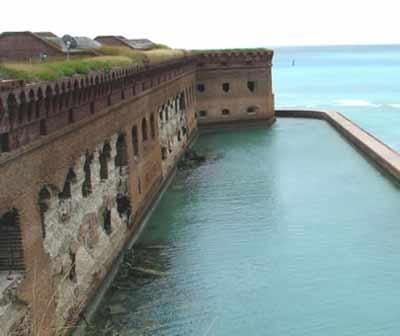Problems with "crumbing infrastructure" throughout the national park system have received plenty of press in recent years, and for good reason. A report from Dry Tortugas National Park this week offers a literal example of a key park resource that's "crumbling"…or worse. According to information from the park, "A recent report on the instability of the Front Three wall of the historic Fort Jefferson on Garden Key indicated that this side of the fort could collapse at any time."
That's a sobering bit of news indeed, but a park spokesperson assured us by phone that visitors to the park would not be affected by the problem.
The issue involves "substantial cracks" in the interior arches in the casemates in a section of the fort which is currently used for park maintenance shops, the employee laundry, the park clinic and some employee housing. Work is underway to relocate those activities to other areas of the fort, and this will cause major disruptions of day to day activities for the staff.
Those moves are no small feat, especially given the small staff and the isolated location of the old fort. These islands in the Gulf of Mexico known as the Dry Tortugas are the home of one of the most isolated NPS sites in the country. The park is physically closer to Cuba than the U. S. mainland.
Fort Jefferson is one of the largest all-masonry forts in the world, and efforts to stabilize the structure have been underway for several years. It's a big project, and work on the area involving this latest problem isn't even underway. It's included in funding requests which have been "in the hopper" for some time. It's not yet known when money for this work might become available.
NPS maintenance personnel from several other parks have been mobilized to assist in relocating activities out of the threatened section of the fort, and it's hoped they can perform some emergency work to help stave off actual collapse of the wall, until long-term stabilization can be completed.
Some pundits have questioned the urgency of the enormous "maintenance backlog" in our parks, and finding funding to make a serious dent in the problem has been an uphill fight. Let's hope the walls don't have to come tumbling down at Fort Jefferson to prove this example of a crumbling infrastructure isn't just a rhetorical exercise.




Comments
Rather than depending on "development project funding" for line item Congressional construction funding, many parks should have maintenance staff able to continually maintain the park.
Ft. Jefferson/Dry Tortugas is one of those parks.
For example, Fort Stanwix in New York is a fort made out of logs, which also need continuous maintenance. Logs need to be replaced when they rot. Ft. Stanwix used to have a brilliant Superintendent, Gary Warshefski, who made a point of keeping funding in his budget for a senior maintenance man who knew how to perform on going maintenance on those logs. The maintenance man made sure he had a supply of properly aged logs ready to be installed as needed, and he knew the most effecient and appropriate way to do the work.
But there is constant pressure to cut staff, and do such work through construction contracts, funded with project funding. But by hanging on to this senior maintenance man, Ft. Stanwix always looked great, for comparatively small bucks.
With this 'modern' approach of construction contracts, not only do you have no one on your staff who really knows how to maintain the resource, but parks are in a constant state of decay. As soon as a construction project is complete, all structures start to deteriorate unless continually maintained. The solution of many -- not all -- backlog problems is a properly staffed park, with NPS professionals.